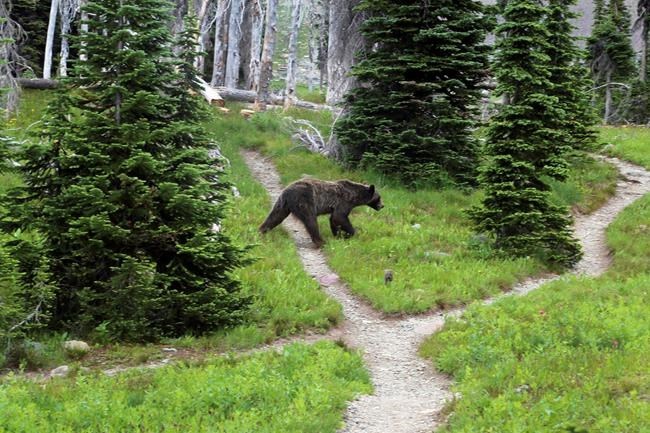
FILE - In this Aug. 3, 2014, file photo, a grizzly bear walks through a back country campsite in Montana's Glacier National Park. U.S. Fish and Wildlife grizzly recovery coordinator Hilary Cooley says a proposal to lift threatened species protections for an estimated 1,000 grizzlies in northwestern Montana could come next year. (Doug Kelley /The Spokesman-Review via AP, File)
Republished September 29, 2017 - 3:45 PM
Original Publication Date September 29, 2017 - 8:21 AM
BILLINGS, Mont. - On the heels of lifting protections for Yellowstone-area grizzly bears, the U.S. government is considering the same action for bruins in northwestern Montana, home to the largest group of grizzlies in the Lower 48, federal officials said Friday.
Hunters and trappers widely exterminated grizzlies across much of the U.S. early last century. But after being granted threatened species protections in 1975, the animals have made a dramatic comeback around Yellowstone and a second area centred on Glacier National Park, known as the Northern Continental Divide Ecosystem.
The mountainous ecosystem along the Canadian border has about 1,000 bears. The population has more than doubled since 1993, and biologists say the bears now occupy at least 22,000 square miles (56,000 square kilometres.)
State Rep. Bradley Hamlett said lifting federal protections would allow Montana to hold "extremely limited" grizzly hunts. That could help deter run-ins between bears and humans that have become more common as the animals spread onto the plains east of Glacier, he said.
A grizzly bear earlier this month killed 10 calves east of the park near the small town of Dupuyer. On Sunday a grizzly was shot and killed by a man after it attacked his adult son while the pair was hunting black bears west of Kalispell.
"I'm all for grizzly bears, but everybody's got to realize they were a plains animal," said Hamlett, a Democrat from Great Falls. "You don't want to shoot them all and get rid of them. But the bears will adjust and there won't be as many bad encounters."
By year's end, the U.S. Fish and Wildlife Service expects to release details on criteria it will use to determine if the Northern Continental Divide population has enough habitat to protect it from the threat of extinction, U.S. Fish and Wildlife spokesman Steve Segin said.
The bears have long since exceeded a minimum population level of 391 grizzlies that was established as a recovery goal in a 1993 Fish and Wildlife plan that's still in use.
After a public comment period on the draft habitat plan, a proposal to lift protections could come next year, officials said. It would take another year for such a proposal to be finalized.
In recent years, grizzlies have pushed out of the mountains around Glacier and onto central Montana's plains, where agriculture dominates the landscape. Conflicts between grizzlies and livestock have increased.
Similar conflicts have occurred in communities around Yellowstone National Park. Facing increased pressure from state officials, the federal government in July lifted protections on an estimated 700 grizzlies in the Yellowstone region of Idaho, Montana and Wyoming.
The action transferred jurisdiction over grizzlies to state game agencies, possibly opening the door to trophy hunts in the future.
Wildlife advocates and American Indian tribes have filed multiple lawsuits asking federal courts to restore protections for Yellowstone-area grizzlies. They worry the bears' recovery will nosedive without U.S. government oversight.
Grizzlies occupy three other areas in the Lower 48: about 40 bears are in the Cabinet Yaak area of Montana; 70 to 80 in the Selkirk Mountains of Idaho, Washington and British Columbia; and fewer than 20 are in the North Cascades of central Washington, according to the Interagency Grizzly Bear Committee.
Grizzlies are not federally protected in Alaska, which has tens of thousands of the animals and holds annual public hunts.
___
Follow Matthew Brown on Twitter at www.twitter.com/matthewbrownap .
News from © The Associated Press, 2017